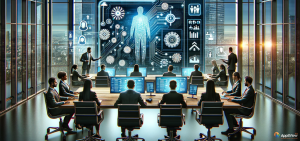9 Ways to Use AI in Human Resources
September 13, 2024

AI is revolutionizing Human Resources by automating recruitment, enhancing employee onboarding, improving engagement, and streamlining performance management. It enables personalized learning, efficient workforce planning, and automated compliance, driving data-driven decision-making and enhancing the employee experience.
9 Ways to Use AI in Human Resources
AI is revolutionizing industries, and HR is no exception. From automating repetitive tasks to providing deep insights into employee engagement, AI is reshaping HR operations, making them more efficient, strategic, and data-driven. In this blog, we’ll explore nine innovative ways AI is being used in Human Resources and how it can help your organization thrive in today’s competitive landscape.
1. Automated Recruitment and Talent Acquisition
AI-powered recruitment tools streamline the hiring process by automating repetitive tasks such as resume screening and scheduling interviews. These tools can quickly sift through thousands of resumes to identify the best candidates based on predefined criteria.

2. Enhanced Employee Onboarding
AI can significantly enhance the onboarding process by providing new employees with personalized onboarding experiences. AI-driven chatbots can guide new hires through the onboarding process, answer frequently asked questions, and provide real-time assistance.
3. Improved Employee Engagement and Retention
AI tools can analyze employee engagement data from various sources such as surveys, emails, and collaboration tools to identify patterns and trends. By understanding employee sentiment and engagement levels, HR teams can proactively address issues, improve workplace culture, and implement strategies to boost employee satisfaction and retention.
4. Streamlined Performance Management
AI-powered performance management systems provide a more objective and data-driven approach to evaluating employee performance. These systems can analyze vast amounts of data, such as project outcomes, sales numbers, and peer reviews, to provide a holistic view of an employee’s performance.
5. Personalized Learning and Development
AI can revolutionize corporate training by offering personalized learning experiences. AI algorithms can analyze an employee’s skills, career goals, and learning preferences to recommend tailored training programs and resources.
6. Efficient Workforce Planning
AI can assist in workforce planning by analyzing data related to employee turnover, recruitment needs, and business goals. Predictive analytics can forecast future hiring needs and skill gaps, allowing HR teams to plan strategically.

7. Automated Compliance and Reporting
HR departments are often burdened with compliance requirements and reporting obligations. AI can automate these tasks, ensuring that the organization complies with regulations and that reports are accurate and timely.
8. Data-Driven Decision Making
AI empowers HR professionals to make data-driven decisions by providing deep insights into workforce analytics. By leveraging big data and advanced analytics, HR teams can uncover trends, predict future workforce needs, and identify areas for improvement.
9. Enhancing Employee Experience
AI can enhance the overall employee experience by providing personalized support and resources. For example, AI-driven virtual assistants can help employees navigate HR processes, find information, and access resources quickly and easily.
Conclusion
AI is transforming Human Resources by automating mundane tasks, providing data-driven insights, and enhancing employee experiences. By leveraging AI, HR teams can focus more on strategic initiatives that drive organizational growth and success.
